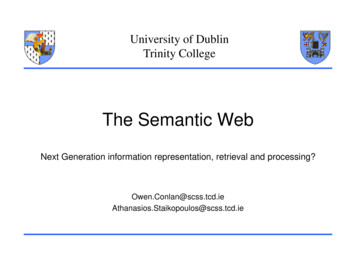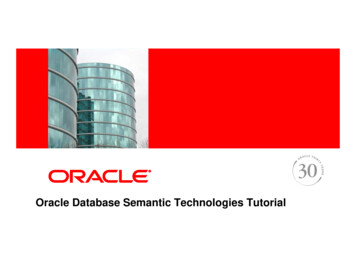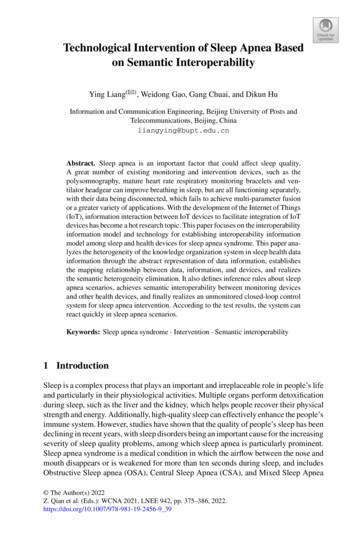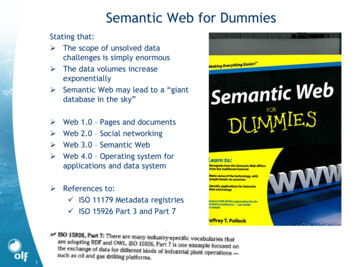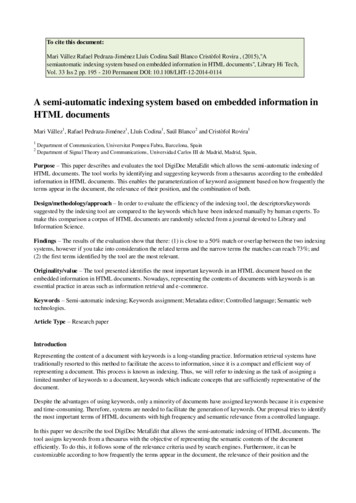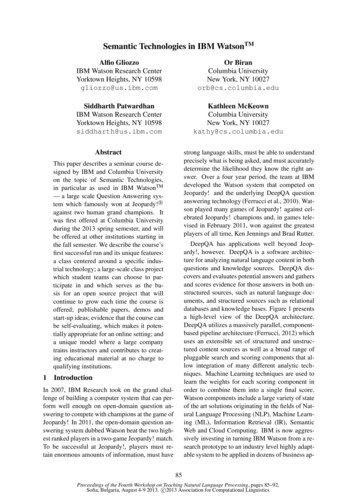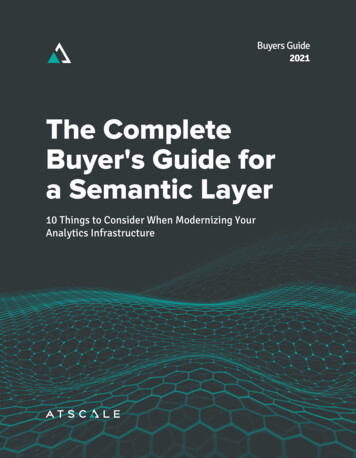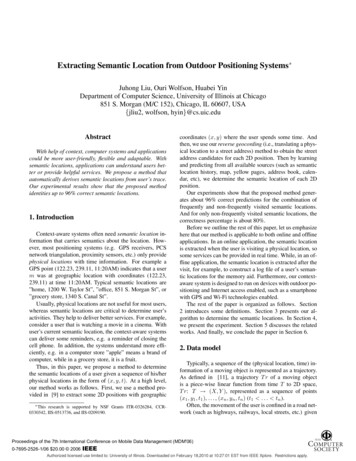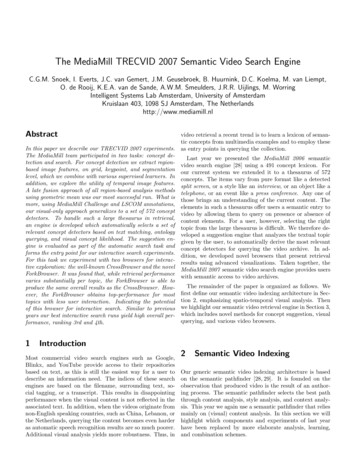
Transcription
Semantic Web Technologies and Data ManagementLi Ma, Jing Mei, Yue PanIBM China Research LaboratoryBei Jing 100094, ChinaKrishna KulkarniIBM Software GroupSan Jose, CA 95141-1003, USAAchille Fokoue, Anand RanganathanIBM Watson Research CenterNew York 10598, USAIntroductionThe Semantic Web aims to build a common framework that allows data to be shared and reused across applications,enterprises, and community boundaries. It proposes to use RDF as a flexible data model and use ontology to representdata semantics. Currently, relational models and XML tree models are widely used to represent structured andsemi-structured data. But they offer limited means to capture the semantics of data. An XML Schema defines asyntax-valid XML document and has no formal semantics, and an ER model can capture data semantics well but it ishard for end-users to use them when the ER model is transformed into a physical database model on which user queriesare evaluated. RDFS and OWL ontologies can effectively capture data semantics and enable semantic query andmatching, as well as efficient data integration. The following example illustrates the unique value of semantic webtechnologies for data management.Figure 1. An example of ontology based data managementIn Figure 1, we have two tables in a relational database. One stores some basic information of several companies, andanother one describes shareholding relationship among these companies. Sometimes, users want to issue such a query“find Company EDOX’s all direct and indirect shareholders which are from Europe and are IT company”. Based on thedata stored in the database, existing RDBMSes cannot represent and answer the above query. We want to retrieveshareholders in Europe, however, companies register their location in terms of cities. Similarly, we want to returnshareholders in IT industry, however, companies register their business in terms of specific IT products. Also, we want toreturn both direct and indirect shareholders, which requires recursive look up where the number of iterations can not beknown before evaluation. It is clear that the query is asked at a different level of concept granularity and a recursive lookup is needed. We consider that the problem is not only caused by the use of different terms, but also that certainontological knowledge is missing. By introducing two types of ontologies and leveraging inference implied by them, wecan solve the above query effectively. The first type of ontologies encodes domain knowledge, such as the “Region” and“Business” ontologies which describe commonly-used classification trees for geography and industry, respectively. Suchontologies link specific data values to domain terms directly. Another kind of ontologies can be considered as a semanticrepresentation of the data stored in databases. A simple example is the ontology shown in the top right of Figure 1, whichdescribes entities and their relationships in the database and their formal definition, and thus provides a profile of thedatabase information to users. In order to enable users to issue and evaluate queries based on the defined ontology forsemantic representation, we need to map the data in relational tables to concepts and properties of the ontology. Figure 1shows only a simplified (incomplete) mapping for illustration purpose. In summary, we can utilize ontologies to encodedomain knowledge and provide a semantic representation to the information in databases, and further leverage ontologyreasoning to solve the granularity mismatch between user queries and the data in databases, and answer semantic queries.Furthermore, ontologies which capture the semantics of the data will facilitate data integration as illustrated in [21].Given that ontologies have unique values for semantic queries and information integration, it is worthy to investigate theproblems of their use in data management. In this paper, we firstly survey the interoperability among relational data,XML and RDF, and that of SQL, XQuery and SPARQL. Then, we make a case study to illustrate the need and value ofRDF representation and access to master data, and introduce some research work on Semantic Web from IBM. Finally,we discuss some open questions when publishing relational data as RDF resources and enabling ontology reasoning overlegacy relational data.
The Interoperability of RDF Data with Relational and XML DataWe observed two interesting findings from the history of relational and XML databases. Firstly, from query perspective,it is desirable that an existing query language is extended to retrieve a new type of data, allowing information from twoformats to be correlated. For instance, use SQL to query both existing relational data and new XML data. Secondly, fromdata management perspective, it is valuable to express existing data with a newly-defined data model and query themwith the corresponding query language. For example, publish relational data in an XML form for exchange purpose anduse XQuery to retrieve them from databases. Here, we briefly summarize the potential interoperability of semantic webwith relational and XML databases from data management and query perspectives.Table 1 illustrates some extensions of existing query languages for access to new types of the data. It is well-known thatSQL is extended to query both relational and XML data, namely SQL/XML, allowing SQL queries to create XMLstructures with a few powerful XML publishing functions. Assuming that relational databases serve as XML storage,XQuery queries need to be rewritten into SQL queries, as the XML extensions of commercial implementations provide.Alternatively, native XML databases have been developed and commercialized, which need to join results of XQueryand SQL. Similarly, with the development of RDF, SQL is also considered to support SPARQL queries, which has beenimplemented in a commercial database [2]. Currently, there are few native RDF databases and most RDF stores havebeen built on relational databases. Generally, RDF graphs are decomposed into triples, and the resulting RDF triples areshredded into a relational table of three columns (Subject, Property, Object). Rewriting queries from SPARQL to SQLbecomes a challenge, utilizing well-developed SQL engines in a most effective manner. Specially, translating a completeSPARQL query into a single SQL statement is attractive, so that the generated SQL can be directly embedded as asub-query into other SQL queries [4]. In addition, not losing beloved XML tools, RDF seems accessible by extendingXQuery. On the one hand, an XML syntax specification for RDF, namely RDF/XML, has been defined in W3Crecommendation, which implies RDF files as valid XML files. On the other hand, problems arise when uniting a graphstructure of RDF with a tree structure of XML, and unfortunately, there is no canonical RDF/XML serialization.Consequently, XQuery with functional accessors is used to address the RDF graph and match parts of RDF statements.In particular, TreeHugger, using XQuery syntax to access RDF data, appears as another RDF query system based on pathrather than graph matching.Table 1. Extensions of existing query languages for the access to new types of the dataHostExtended LanguageLanguage RDFqueryStorageTechnicalRequirementsXML in relational Rewriting queriesdatabasesfrom XQuery to SQLNative XMLJoin results ofdatabasesXQuery & SQLSQL tableRDF in relational Rewriting queriesfunctiondatabasesfrom SPARQL to SQLNative RDFJoin results ofdatabasesSPARQL & SQLXQuery with RDF inNormalized XML representationFunctionalXML serialization of RDF; SPARQLAccessors;implementation using XQueryNative RDFJoin results ofdatabasesSPARQL & XQueryImplementationExamplesXML extension incommercial databasesCommercial nativeXML storesCommercial RDFstoresN/ATreeHuggerN/ANewly-defined data models and query languages can implement their values over legacy data sources by publishing andquery rewriting technologies. The following table summarizes such work. As the support of XQuery over relational datais well-known, we address the problem of SPARQL access to relational and XML databases. We can put an RDF cap fora relational data source, and a representative is D2RQ mapping [5], which treats non-RDF relational databases as avirtual RDF graph by generating URI patterns in ClassMap and PropertyBridge. Similarly, SquirrelRDF [8] provides thedatabase mapping which could be automatically configured so that tables become RDF classes and columns becomeRDF properties with the table class as their domain. Alternatively, OpenLink Virtuoso [6] renders relational schema intoRDF by assigning a property URI to each column and an rdf:type property for each row linking it to an RDF class URIcorresponding to the table. Others, allowing non-RDF relational data to be queried using SPARQL, include SPASQL(SPARQL support in MySQL) [9] and Relational.OWL (a data and schema representation format based on OWL) [7].Based on the built mapping between relational schema and ontologies, SPARQL queries can be rewritten into SQLstatements to retrieve relational data. Note that, SPARQL seems to be close to recommendation; however the formalsemantics of SPARQL is still an open issue, resulting in different methods for SPARQL support. Perez et al. proposedone [11], regarding AND as the SQL join, UNION as the SQL union, OPT as the SQL left outer join, etc. Recently,refined and extended versions are presented in [12], having three variants, namely bravely joining, cautiously joiningand strictly joining semantics, where the bravely joining semantics coincides with [11]. In particular, based on the threesemantic variants, [12] also provides translations from SPARQL to Datalog with negation as failure, which might servestraightforwardly to implement SPARQL within existing rule engines. As some existing applications have used XMLdatabases to manage their data, supporting SPARQL access to XML databases is also attractive for integration. But now,there is little such work. A related work is GRDDL (Gleaning Resource Descriptions from Dialects of Languages) whichprovides the mechanism to extract RDF data from general-purpose XML documents. Because of the semanticsdifferences between different query languages, we believe attempts to extend SQL and XQuery to support
SPARQL would involve considerable complexity. Hence, we advocate focusing research efforts on publishing andaccessing relational (and XML) data as RDF data and exploiting SPARQL for semantic query and integration.Table 2. Publishing and accessing legacy data using new data models and query languages.Language Data SourcesTechnical RequirementsImplementation ExamplesXQuerySPARQLSPARQLRelational databases Publish relational data as XMLRewrite XQuery to SQLRelational databases Publish relational data as RDFRewrite SPARQL to SQLXML databasesPublish XML data as RDFRewrite SPARQL to XQuery ;Commercial databasesD2RQ mapping and D2R ServerVirtuoso; SPASQLN/AA Case Study: RDF Representation and Access to Master DataMaster data, as the core business entities a company uses, refers to lists or hierarchies of customers, suppliers, accounts,products, or organizational units [16]. In this scope, Product and Customer Information play a very important role sincetheir accurate management is becoming critical for modern enterprises. They enable companies to centralize, manageand synchronize all product and customer information with heterogeneous systems and trading partners. The mostcritical challenge is the need to build a common master model flexible enough to deal with business changes, andexpressive enough to represent the semantics of master data.To enhance IBM master data management (MDM) solutions (Websphere Product Center and Websphere CustomerCenter) [15], we developed semantic technologies for Product Information Management (PIM) and Customer DataIntegration (CDI), respectively. Here, we would like to highlight the value of semantic web technologies for MDM andbrief completed and ongoing work. As introduced in our previous work [1], the advantages of OWL ontologies forproduct information include followings:z As based on RDF, OWL uses the concept of Universal Resources Identifiers (URIs) as Web-based identificationscheme. It firstly allows one to refer to industry specific or external ontologies; and on the other hand it allowssynchronization of product information management utilities to other core business entities, such as those in customerdata integration (CDI).z OWL allows the definition of richer properties and relationships. Object Properties can be defined as symmetric,functional, inverse functional, or transitive. Object Properties are then suitable to describe complex relationshipsamong products and between products and other entities in product information.z The expressivity of OWL allows the definition of logical classes (intersection, union and complement operators),which enables automatic classification for product items. For instance, new product categories can be defined as theintersection of two others: smartphones products, which gather characteristics of both PDA and phones, are a goodexample. Any product which is simultaneously a PDA and a phone is then a smartphone.z OWL restrictions can define dynamic categories which do not exist in the pre-designed category hierarchy and arespecified by users at query time. It can represent complex and potentially evolving categories. For example, usingMinimum cardinality restriction, it is possible to define an “outdated products” category which gathers all productsreplaced by at least one other product. Items of dynamic categories can be retrieved using OWL ontology reasoning.Details of RDF representation of PIM can be found in [1]. Since IBM PIM system currently uses technologies similar tothe triple store for storage (item-property-value), we support SPARQL queries over PIM storage easily by reusingSPARQL2SQL query translation technologies developed in [17]. The query rewriting method translates a SPARQLquery into a single SQL statement, utilizing well-developed SQL engines in a most effective manner.Figure 2. Conceptual Architecture for SPARQL Queries over the CDI system
The advantages of OWL ontologies for customer information are similar to those for product information. Representingand discovering various relationships among customers has a very high value for the CDI, which is enabled by ontologyand rule reasoning. Different from the PIM system, IBM CDI system makes use of object-oriented database schema forstorage. Each entity of the CDI model owns a separate table to store corresponding instances. So, we need a mapping tolink the CDI data with the OWL ontology generated and enriched from the CDI logical model. We proposed thefollowing conceptual architecture to develop a POC system for RDF Access to the IBM CDI system. Note that theontology view in the bottom right of Figure 2 is in fact a virtual representation of the CDI data in SOR’s schema form[4], over which IBM SHER engine for ontological reasoning can work directly. In the future, we will support SHERengine over a D2RQ like mapping [5], and thus replace the ontology views component. Besides the mapping betweenrelational DB and ontology, it is critical to construct an appropriate RDF representation (ontology) for relational data.The challenge in using domain knowledge in ontologies effectively is in crafting “integrating” ontologies that tie thedomain knowledge in ontologies with other ontologies that may be used to model the relational data in the database. Forexample, in Figure 1, a crucial piece in answering the query is the ontology in top right, which ties the data in therelational DB with the domain ontologies describing regions and businesses. We would need to come up with guidelinesand best practices for developing these ontologiesIBM’s Semantic Web Tools and SystemsHere, we briefly introduce some IBM’s ontology tools and systems related to RDF Access to relational data. IODT [10]is a toolkit for ontology-driven development, including EMF Ontology Definition Metamodel (EODM) and an OWLOntology Repository (named SOR). EODM is derived from the OMG's Ontology Definition Metamodel (ODM) [13]and implemented in Eclipse Modeling Framework (EMF). It is the run-time library that allows the application to put inand put out an RDFS/OWL ontology in RDF/XML format; manipulate an ontology using Java objects; call an inferenceengine and access inference results; and transform between ontology and other models. SOR [4] is an OWL ontologystorage and query system on the relational DBMS. It supports Description Logic Program (DLP), a subset of OWL DL,and SPARQL query language. SHER reasoner [14] uses a novel method that allows for efficient querying of SHINontologies with large ABoxes stored in databases. Currently, this method focuses on instance retrieval that queries allindividuals of a given class in the ABox. It is well known that all queries over DL ontologies can be reduced toconsistency check, which is usually checked by a tableau algorithm. SHER groups individuals which are instances of thesame class into a single individual to generate a summary ABox of a small size. Then, consistency check can be done onthe dramatically simplified summary ABox, instead of the original ABox. It is reported in [14] that SHER can processABox queries with up to 7.4 million assertions efficiently, whereas the state of art reasoners could not scale to this size.As described in the example shown in Figure 1, to enable semantic queries over existing data sources, we need to storeand leverage ontologies representing domain knowledge. SOR could be used to manage such ontologies. Similarly, inthe CDI case, we need an ontology repository to cache and materialize some inference results for performanceimprovement. In general, an RDF store, such as SOR, could be used to store domain knowledge or part of reasoningresults for RDF access to relational databases. Obviously, SHER engine could be used for scalable ontological reasoningfor SPARQL queries over relational databases. The system described in [22] takes an ETL (Extract-Transform-Load)approach, where the relational data in the database is extracted, transformed into RDF triples based on a set of domainontologies and mapping rules, and loaded into SOR. This system also provides mechanisms to handle updates to therelational database as well as to the ontologies.DiscussionsThere are three key steps when exposing relational data as RDF data, creating an RDF Representation (ontology) of therelational data, building a mapping between the relational database and ontology, and rewriting SPARQL queries toretrieve the relational data. Recently, progresses have been made in these three aspects, but following challenges need tobe paid more attentions.zURI Generation for the relational data: Recalling that RDF resources are identified by URI, efforts in choosing goodURIs for relational data are worthy. Tim Berners-Lee ever uses a term, “cool”, for URIs designed with simplicity,stability and manageability in mind [18], and a recent article [19] presents two strategies, called 303 URIs and hashURIs. Another solution, proposed in [20], ends up with three URIs related to a single non-information resource, i.e.,an identifier for the resource, an identifier for a related information resource suitable to HTML browsers with a webpage representation, and an identifier for a related information resource suitable to RDF browsers with an RDF/XMLrepresentation. The problem of URI generation deserves more efforts. Another related problem is instance-mapping,i.e., how a particular data element in a cell may be mapped to the URI of an individual in an OWL ontology.zN-Ary Relationship Representation and Query: Our experiences show that real applications often include a largenumber of N-Ary relationships. But, ontologies are limited to represent N-Ary relationships and SPARQL does nothave built-in constructs for them. In practice, therefore, we usually use RDFS classes to express N-Ary relationshipsand rules to specify reasoning on them, instead of built-in constructs, like transitive property. A graceful way torepresent N-Ary Relationship in ontologies is desirable, using the best practices documented athttp://www.w3.org/TR/swbp-n-aryRelations/ as a starting point.zRepresentation of RDB Schema Constraints in Mapping: As we know, an RDB schema uses a set of built-invocabularies to represent table structure. For instance, the term UNIQUE denotes that the data value of a column isboth NOT NULL and distinct. Such information is highly valuable for query rewriting (and thus for informationintegration) and should be included in the mapping from RDB to RDFS/OWL ontology. Unfortunately, existingmapping techniques do not capture such information. So, it is desirable to develop a powerful standard mappinglanguage in the future.
zEffective Query Rewriting and Optimization: Translating SPARQL queries to SQL queries is widely studied in RDFdata management. Filter expressions, which restrict the graph pattern matching solutions to express specificrequirements on results, often consist of multiple functions and operators, and a filter operator may have differentbehaviors on different operands. Existing systems, such as Sesame and Jena2, usually adopt memory-based methodsto evaluate SPARQL filter expressions, rather than directly leveraging the database query engine. Lu et al. [17]proposed an effective method to translate a SPARQL query with filter expressions into a single SQL query, makinguse of optimized database query engines as much as possible. Effective query rewriting and optimization based on themapping from RDB to ontology need further investigation.zReasoning Issues: One advantage of using OWL ontologies is that DL reasoning can be used to return additionalresults to queries. However, this brings additional issues, particularly when more expressive logics are used. One issueof importance is reconciling the closed world nature of databases with the open world nature of Description Logicreasoning.zPerformance and Security Issues: A relational data source supports a specific kind of applications. When we exposesuch a data source as an RDF source, we need to consider access control issue and performance impact. SPARQLqueries and ontology reasoning on a data source may need expensive database operations and thus impact theperformance of existing applications over the same data source. So, it is valuable to study such impact in depth.From modeling perspective, we think there are three key issues to implement semantic web technologies enabled datamanagement and integration. The first is on the semantic web data representation, such as RDFS and OWLspecifications. The second is on the ontology mapping which defines correspondences among different ontologies. Thethird issue is on the mapping between ontology and underlying data sources (such as relational databases and XMLstores). Considering that most existing data is stored in relational databases, it is highly valuable to expose relational datain an RDF format with semantics defined in ontologies. Currently, W3C has recommended RDFS and OWL asspecifications, and is organizing OWL 1.1 working group to discuss problems when applying OWL in practice and thusmake corresponding extensions to OWL. Research efforts on the 2nd and 3rd issues are significant, but withoutspecification support yet. One reason, we think, is that OWL1.1 extension is ongoing and may affect the latter two issuesseriously. So, when to start working on standards for the mapping among ontologies and RDF representation forrelational data may depend on the maturity of the extended OWL specification. In summary, we think that:zExpressing and accessing relational data as RDF resources through a mapping between database and ontologyis highly valuable;zThere are still many interesting research problems that need to be solved. We advocate setting up an incubatorgroup or a working group to identify and address all such problems before embarking on any 12.13.14.15.16.17.18.19.20.21.22.J-S. Brunner, L. Ma, C. Wang, L. Zhang, Y. Pan, K. Srinivas. Explorations in the use of Semantic Web Technologiesfor Product Information Management. In Proc. of WWW 2007, pp. 747 - 756.C. Murray, N. Alexander. Oracle Spatial Resource Description Framework (RDF), 10g Release 2 (10.2), 2005.J. Melton. SQL, XQuery, and SPARQL: Making the Picture Prettier. In Proc. Of XML 2006.J. Lu, L. Ma, L. Zhang, J-S. Brunner, C. Wang, Y. Pan, Y. Yu. SOR: A Practical System for OWL Ontology Storage,Reasoning and Search. In Proc. of VLDB 2007, to appear.D2RQ. irtuoso. QLRDFRelational.OWL. irrelRDF. http://jena.sourceforge.net/SquirrelRDF/SPASQL: SPARQL Support In MySQL. http://www.w3.org/2005/05/22-SPARQL-MySQL/XTechIBM Integrated Ontology Development Toolkit. http://www.alphaworks.ibm.com/tech/semanticstkJ. Pérez, M. Arenas, C. Gutierrez. Semantics and Complexity of SPARQL. In Proc. of ISWC 2006, pp. 30 - 43A. Polleres. From SPARQL to Rules (and back). In Proc. of WWW 2007, pp. 787 – 796Ontology Definition Metamodel (ODM) Request for Proposal, OMG Document: -05-01.pdf.J. Dolby, A. Fokoue, A. Kalyanpur, A. Kershenbaum, L. Ma, E. Schonberg, K. Srinivas. Scalable SemanticRetrieval Through Summarization and Refinement. In Proc. of AAAI 2007, pp. 299 - 304.IBM Multiform Master Data Management. masterdata/H.D. Morris, D. Vesset. Managing Master Data for Business Performance Management: The Issues and Hyperion'sSolution. IDC white paper, 2005.R. Lu, F. Cao, L. Ma, Y. Yu, Y. Pan. An Effective SPARQL Support over Relational Databases. In Proc. ofSWDB-ODBIS07 co-located with VLDB 2007, to appear.T. Berners-Lee. Cool URIs don't change. http://www.w3.org/Provider/Style/URIL. Sauermannh, R. Cyganiak, M. Volkel. Cool URIs for the Semantic Web. DFKI Technical Memo TM-07-01C. Bizer, R. Cyganiak, T. Heath. How to Publish Linked Data on the b/LinkedDataTutorial/N. Noy. Semantic Integration: A Survey of Ontology-Based Approaches. SIGMOD Record, 33(4), 2004A. Ranganathan, Z. Liu. Information Retrieval from Relational Databases using Semantic Queries. In Proc. of ACMCIKM 2006, pp. 820 - 821
To enhance IBM master data management (MDM) solutions (Websphere Product Center and Websphere Customer Center) [15], we developed semantic technologies for Product Information Management (PIM) and Customer Data Integration (CDI), respectively. Here, we would like to highlight the value of semantic web technologies for MDM and
